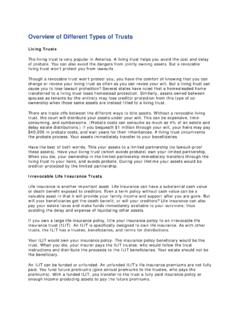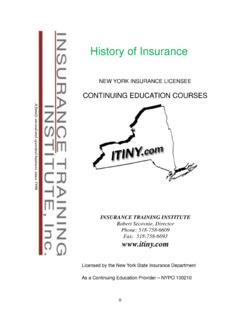Transcription of Creditor Protection for Life Insurance and Annuities
1 Creditor Protection for life Insurance and Annuities by Gideon Rothschild and Daniel S. Rubin Unlike man, all assets are not created equal-at least from an asset Protection planning standpoint. Instead, some assets are favored by statute so as to provide their owner (herein referred to generally as the "debtor") a greater level of Protection from the claims of creditors than do other assets. Usually this heightened level of Protection , offered under either the federal Bankruptcy Code1 or a state's alternate statutory exemption scheme2 is provided because the asset is considered essential for the debtor and the debtor's family to maintain at least a minimum level of financial well-being and thereby avoid becoming a burden to the state.
2 The extent of such Creditor Protection is, of course, tempered by society's proper concern for the Creditor 's competing rights to access the debtor's property for the satisfaction of legitimate claims. After the homestead exemption, retirement plans and individual retirement accounts (IRAs) are, perhaps, the most widely recognized and obvious examples of such favored assets since, like the homestead exemption, they help to ensure a debtor's financial Since commercial Annuities often substitute for or supplement retirement plans and IRAs, it should come as no surprise that, to a greater or lesser extent, they too are generally exempted by statute from the claims of creditors .
3 life Insurance is often similarly favored because it can serve a similar function with regard to the debtor's spouse and dependents after the "bread winning" debtor's death. (This discussion assumes that the purchase of the annuity or Insurance contract does not constitute a fraudulent transfer under applicable federal or state law since, under that scenario, any protections that would otherwise be afforded are vitiated by the fact of the fraudulent transfer.) Notwithstanding the foregoing, however, the exemptions afforded to life Insurance and Annuities are frequently more limited, more widely varied by jurisdiction, and seemingly more subject to the vagaries of the presiding courts than are the exemptions afforded to retirement plans and IRAs.
4 For example, the Supreme Court has ruled, in Patterson v. Shumate,4 that retirement plans that are qualified under ERISA (29 section 1001, et seq.) are exempt from the claims of the employee's creditors pursuant to 11 section 541(c)(2) as an enforceable spendthrift trust under "applicable non-bankruptcy law." Furthermore, by association, IRAs established under Internal Revenue Code (IRC) Section 408 (and most likely Roth IRAs established under IRC Section 408A, as well), may be exempt under 11 section 522(d)(10)(E), which exempts "a payment under a stock bonus, pension, profit sharing, annuity, or similar plan or contract on account of illness, disability, death, age, or length of service.
5 " or under state exemption statutes. Seemingly, this reasoning would also extend to commercial annuity products, at least if held for true retirement planning purposes (rather than as they are sometimes marketed-as a tax-favored investment vehicle), but significant issues remain. Notwithstanding these factors, the potential value of such exemptions to a debtor or potential debtor means that the exemptions warrant a careful and considered review by both asset Protection planners and bankruptcy counsel acting in a pre-bankruptcy planning function.
6 (Although foreign life Insurance and annuity products may offer more Protection from creditors than do their domestic counterparts, such products are beyond the scope of this article.) life Insurance Consideration of the potential Creditor protections afforded to life Insurance contracts is complicated by the several capacities in which the debtor may have an interest in the policy. For example, the debtor can be the owner of the policy, the insured, or both the owner and the insured. Alternatively the debtor may be the beneficiary of the policy or the owner of a policy that names his or her estate as the beneficiary of the policy.
7 To further complicate matters, since the exemptions afforded to life Insurance are intended to further particular public policy goals ( , protecting the debtor's dependents from financial destitution in the event of the debtor's untimely demise), the relationships between the owner and the insured and between the owner and the beneficiary are often key to determining whether and to what extent the particular life Insurance policy at issue may be protected from Creditor claims. These additional permutations exponentially increase the complexity of determining whether the life Insurance policy may be exempted in any particular circumstance.
8 The federal bankruptcy exemptions for life Insurance policies owned by the debtor are found at 11 sections 522(d)(7) and (8), where their relative importance to the average person is, perhaps, evidenced by their placement between the exemptions for the debtor's professional books and tools of the trade and the debtor's professionally prescribed health aids. More specifically, the federal bankruptcy exemptions for life Insurance shield unmatured policies owned by the debtor (other than a credit life Insurance contract)
9 5 and up to $8,6256 of the debtor's aggregate interest in any accrued dividend or interest under, or loan value of, an unmatured life Insurance contract, provided that the insured is either the debtor or an individual of whom the debtor is a Since, however, federal bankruptcy law broadly defines a dependent as including a spouse, regardless of whether the debtor's spouse is actually dependent on the debtor, the exemption will apply without further inquiry so long as either the debtor or the debtor's spouse is the The effect of the foregoing exemption is to protect the actual Insurance element of the policy and little else, since only a minimal portion of the cash surrender value of the policy is afforded any exemption.
10 While the exemption of an unmatured life Insurance contract without the exemption of the cash surrender value may prove invaluable in certain limited circumstances (for example, if the debtor has become uninsurable since the life Insurance policy was originally purchased), it obviously does not provide significant opportunities for asset Protection or pre-bankruptcy planning for the insured. That the primary intent of the Bankruptcy Code as it relates to the exemption of life Insurance is to protect a dependent's interest in the life Insurance policy, rather than the owner's own interest, is further supported by 11 section 522(d)(11)(C).






